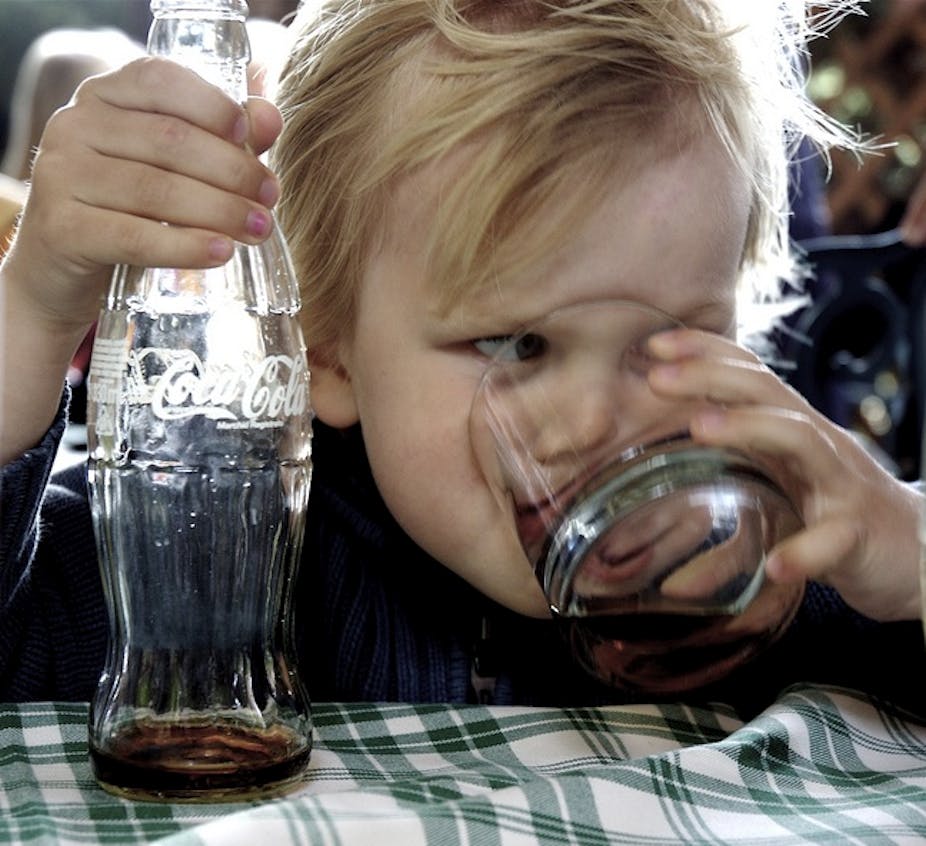Sugary drinks are very popular, almost entirely unnecessary, and contribute to a number of health problems.
Despite such health risks, these drinks are increasingly marketed as healthy with labels highlighting antioxidant, vitamin, mineral, green tea, Taurine, Guarana, Ginseng, Ginkgo Biloba and “energy” content to entice consumers.
But these so-called “functional beverages” and other sweet drinks receive relatively little attention in the mainstream media, even when the topic of discussion is obesity.
Risky sweet drinking
There’s clear evidence linking drinking sugar-sweetened beverages to health risks including weight gain, metabolic syndrome, diabetes, tooth decay and reduced bone density.
Australian studies also show soft drinks are advertised frequently and feature in 24% of outdoor food advertisements in the immediate vicinity of primary schools.
Although, Australian children are eating more healthy “core” foods now than 16 years ago, they get 5% of their energy from sugar-sweetened drinks – more than from any other “extra” food (energy-dense and nutrient-poor snacks, foods and drinks).
Australian adults get more “extra food” calories from sugar-sweetened soft drinks than from the traditional Aussie meat pie, although margarine, cakes and muffins, and beer contribute even more unneeded energy.
The study
News media coverage can place a health problem in the public agenda and influence people’s attitudes toward an issue, as well as their health behaviour.
So we set out to discover whether sweet drinks are portrayed as healthy in Australian media coverage and why they may not be getting as much attention as their health risks would demand.
We analysed one year’s coverage by major Australian newspapers of sweet, non-alcoholic beverages using content and frame analysis.
We asked which sweet drinks are most prominently covered; what makes sweet drinks newsworthy; and how the health aspects of sweet drinks are framed.
The results
Our analysis of newspaper coverage of sweet, non-alcoholic drinks found coverage was positively oriented, with fruit juice primarily portrayed as having health benefits.
But some articles did mention risks of sugary drinks, such as obesity, tooth decay, metabolic syndrome and heart attack.
Fruit juice was the most widely covered sweet drink, closely followed by carbonated, sugar-sweetened soft drinks.
Analysis of the news angles (topic of the headline/lead paragraph) of the articles found 14% led on the health risks of sweet drinks, closely followed by 11% articles talking about their health benefits (largely focused on fruit juices) and a further 3% leading on debates about the health benefits of sweet drinks.
Almost a tenth of articles (9%) led on the profits to be made from sweet drinks, although the same percentage led on the risks in the non-alcoholic beverage market such as the sales woes of “Mother”.
Fears and benefits
Looking at how sweet drinks were framed in the body of the articles, we found around a third (31%) portrayed sweet drinks in a positive light, compared with 22% framing sweet drink negatively.
Where sweet drinks were linked to health (in 43 articles), 53% linked them to health fears and 42% to health benefits (these often talked about fruit juice).
Marketing of sweet drinks was mentioned in 23 articles, of which 61% framed sweet-drink marketing as harmful, 26% as beneficial and 12% as harmless.
The overall prominence of stories was low: one article (about fruit juice in baby bottles rotting toddlers’ teeth) made it to the front page but less than 15% were found in the first five pages of the newspapers.
Without more prominence, the health impact of sweet drinks may languish low on people’s perceptions about what is important.
Mixed drink messages
It seems sweet drinks are somewhat newsworthy, but media interest is slight in comparison to overall coverage of obesity.
The health risks of sweet drinks make up only a small portion of media coverage while positive health messages abound, especially about fruit juice.
The health impact of fruit juice is more complex because while it may contain as much sugar as a fizzy drink, it often contains vitamins as well.
While excess consumption (more than 354ml a day) of fruit juice has been linked to extra weight, other studies find no link between recommended levels of fruit juice consumption and obesity.
But there is some evidence that one extra serve of fruit juice a day is linked to increased risk of diabetes.
The mixed drinks messages found by our study may contribute to a perception that experts are divided, even though there’s growing consensus that soft drinks are unnecessary, bad for health and should be consumed in very small quantities, if at all.
The Public Health Association of Australia suggests making sugary soft drinks cost more and there’s a global push to tax sugar-sweetened drinks.
Reduced sweet drink intake could reduce obesity by as much as one third.
So when you get thirsty the next time, just remember – you just don’t need calories to quench your thirst.

